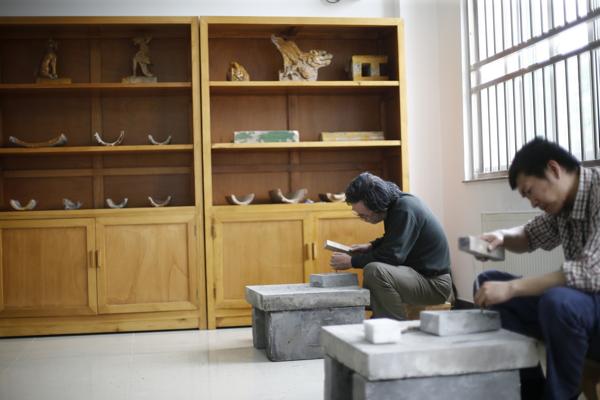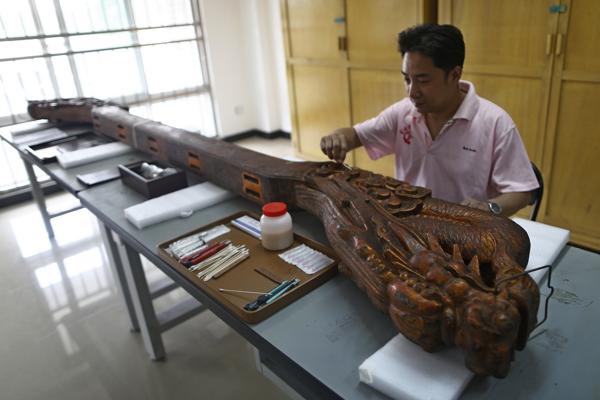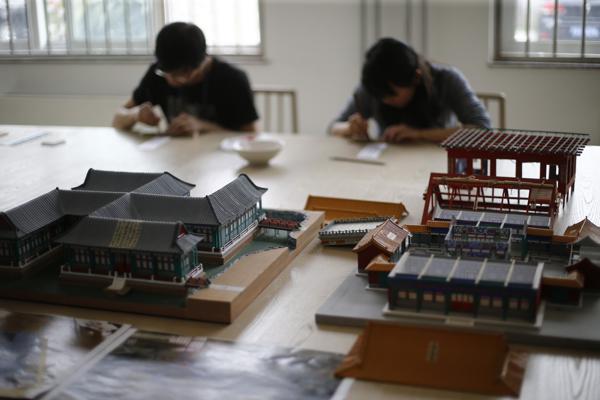
A garden displaying unique plants from the Palace Museum, better known as the Forbidden City, will be part of the new branch of the museum that will be built in the outskirts of Beijing.
The garden was unveiled to media in a briefing, in which journalists were shown the developing new facility, which already includes the world’s biggest relics-repair center to preserve the cultural treasures of the UNESCO World Heritage Site.

A craftsman restores a part of a chime bells frame from the collection of the Palace Museum, at the world’s largest relics-repair center in the museum’s new branch in a northern Beijing suburb.
The new branch of the Palace Museum in northwestern Beijing is the size of 16 football fields. It will display a large number of rare royal treasures that previously couldn’t be shown to the public in the Forbidden City due to limitations on space and safety concerns.
“Visitors will be able to spend a whole day here exploring a Palace Museum surrounded by a large royal garden full of ancient and rare plant species that were once owned by emperors,” says Shan Jixiang, director of the Palace Museum.
“It will be a different experience from the original Palace Museum, which is famous for its royal architecture.”
The new museum has several greenhouses that will house ancient and rare trees and flowers once enjoyed only by emperors and their families. There will be 448 of these rare plants on display. The royal gardening center will conduct research on these rare plants and manage the replica of the royal garden, which is designed to complement the yet-to-be-built museum, which will be home to thousands of rare treasures collected by royal families over hundreds of years.

The Palace Museum has a collection of about 1.8 million relics, most of which are priceless antiques not currently on public display either because of lack of space or because they need repair.
When completed, the new museum will be slightly smaller than the Forbidden City and will function as a display and relics-repair center. Officials started to move relics from the Palace Museum to their new home at the beginning of this month.
Shan says the new museum will be able to easily repair and display large antiques, such as carpets more than 40 meters long and large scroll paintings. An antique repair center, said to be the world’s largest, will also be partly open to visitors.
The repair center will be able to undertake a wide range of restoration work, such as restoring furniture, metal pieces, musical instruments and even the ancient buildings themselves.
Han Qicai has restored royal furniture for about 50 years. He works for a furniture factory that used to serve only emperors. Han is one of the first 12 workers sent from such a factory to help restore hardwood pieces stored in the Palace Museum.
Han says there are tens of thousands of chairs, beds, tables and the like waiting to be restored. However, the shortage of experienced restorers has slowed the process.
Last year, Han mainly focused on fixing a rosewood bed used by the Empress Dowager Cixi. The bed is expected to go on public display in September.
As China’s largest relics-repair center, the new Palace Museum is responsible for training craftsmen in the art of repairing Chinese antiques so the country will have enough people skilled in this important work, says Shan.
Shan says the Palace Museum has trained people from museums in 50 nations. A recent training course on jade authentication attracted many applications from museum directors.
“It takes us six years to train an experienced craftsman. And the trained people can then teach others,” says Shan, adding that China still has a high demand for craftsmen skilled in repairing antiques.
The new museum site is located in northwestern Beijing’s Haidian district, about 30 kilometers from the original museum. The Beijing municipal government has promised to build a subway and a highway close to the new center.
Shan says that as of June 13, the Palace Museum plans to start limiting the number of visitors allowed daily. However, with the opening of the new Palace Museum, more people will have the opportunity to view the treasures of the historic site.
“For new visitors, they can enjoy the imperial architecture in the original museum. Frequent visitors can go to the new venue to see valued treasures in a magnificent royal garden,” says Shan.
Forbidden City limits visitor numbers
The Palace Museum in Beijing will cap the number of daily visitors allowed through the gates beginning on June 13.
Museum director Shan Jixiang says the upper limit for daily visitors will be set at 80,000 to help alleviate the problem of overwhelming crowds during the peak tourist season.
Personal identification cards will also be needed to purchase entry tickets to discourage scalpers, and all group visitors need to book tickets online in advance.
The museum received more than 15 million visitors in 2014 with numbers exceeding 80,000 people on 42 days of the year.
